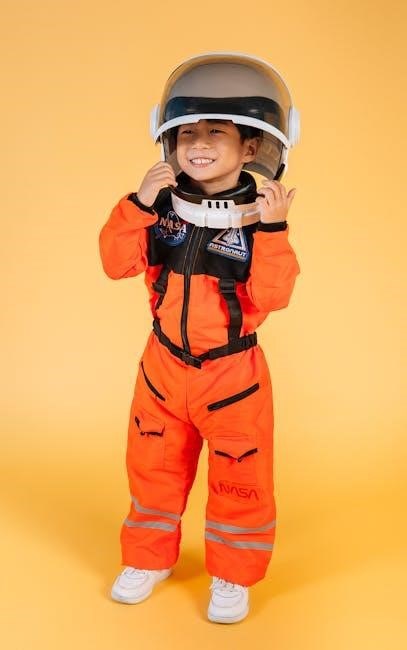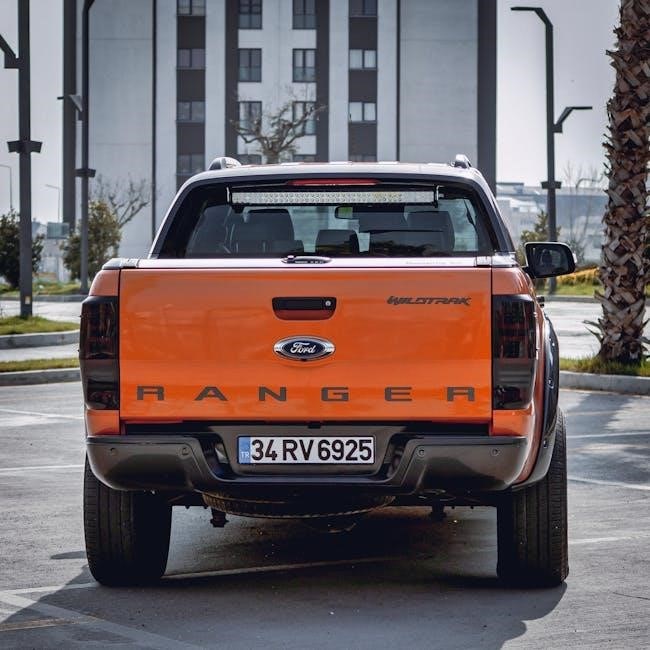Choosing the right helmet size for your child is crucial for safety and comfort․ This guide helps you measure, select, and ensure a proper fit for various activities․
1․1 Why Proper Helmet Fit is Essential for Kids
A proper helmet fit is crucial for safety, as it ensures optimal protection in case of impact․ A well-fitting helmet stays securely in place, reducing the risk of injury․ Ill-fitting helmets can compromise safety and comfort, making kids less likely to wear them․ Always prioritize a correct fit to guarantee effective protection and peace of mind during various activities․

1․2 Brief Overview of Helmet Sizing
Helmet sizing is determined by head circumference, ensuring a secure and comfortable fit․ Size charts vary by brand and activity type, with options for biking, skating, or skiing․ Proper sizing ensures safety and comfort, while ill-fitting helmets can compromise protection․ Always measure accurately and refer to specific size guides for the best fit․
How to Measure a Child’s Head for a Helmet
Measure the child’s head circumference using a flexible tape measure, ensuring it’s level and snug but not too tight, just above the eyebrows and ears․
2․1 Step-by-Step Guide to Measuring Head Circumference
To measure a child’s head, wrap a flexible tape measure around the widest part, just above the eyebrows and ears․ Ensure the tape is level, snug but not tight, and parallel to the floor․ Take note of the measurement in inches or centimeters, ensuring accuracy for proper helmet sizing․ This step is crucial for a safe and comfortable fit․ Always double-check the measurement for reliability․
2․2 Tools Needed for Accurate Measurement
A flexible measuring tape or a digital head measuring tool is essential for accuracy․ A second person can assist in keeping the tape level and snug around the child’s head․ Ensure the tape measure is not too tight or loose, as this can affect the sizing․ Proper tools ensure a precise fit, critical for safety and comfort in any helmet․
Understanding Helmet Size Charts
Helmets are sized based on head circumference measurements․ Size charts map these measurements to specific helmet sizes, ensuring a proper fit for safety and comfort․
3․1 Standard Size Ranges for Kids’ Helmets
Kids’ helmets typically range from extra-small to extra-large, fitting head circumferences of 18-22 inches․ Sizes vary slightly by brand, but standard charts ensure a consistent fit for safety and comfort, making it easier to choose the right helmet for your child’s head size and activity needs․
3․2 How to Interpret Size Charts
Size charts match head measurements to helmet sizes, ensuring proper fit․ Most charts list sizes from extra-small to extra-large, corresponding to specific circumference ranges․ Always refer to the manufacturer’s chart, as sizes can vary slightly between brands․ Accurate head measurements are essential for correct interpretation, ensuring safety and comfort for your child․

Types of Helmets for Different Activities
Different helmets are designed for specific sports, ensuring safety and proper fit․ Bicycle helmets are lightweight, while skate helmets offer more ear protection․ Ski helmets cover ears and often have goggle compatibility, and multi-sport helmets provide versatility for various activities․ Each type is tailored to meet the unique demands of the sport․
4․1 Bicycle Helmets
Bicycle helmets are designed for road safety, with lightweight, aerodynamic designs․ Proper fit is essential, measured by head circumference․ Features include padding, adjustable straps, and ventilation for comfort․ Styles vary, catering to different ages and preferences, ensuring safety and appeal for kids while meeting safety standards for cycling activities․
4․2 Skate Helmets
Skate helmets are designed for skateboarding, inline skating, and similar activities․ They offer robust protection, covering the back and sides of the head․ Proper fit is crucial, determined by head circumference measurements․ Look for helmets with thick padding, secure straps, and ventilation for comfort․ Stylish designs appeal to kids, ensuring they stay protected while enjoying their active lifestyle safely․
4․3 Ski and Snowboard Helmets
Ski and snowboard helmets are essential for winter sports safety․ They feature insulation for warmth and a snug fit to prevent shifting during high-speed activities․ Look for helmets with adjustable sizing to accommodate growing heads and ensure a secure fit without compromising comfort․ Proper measurement ensures maximum protection, making them a vital investment for kids engaging in snow sports․
4․4 Multi-Sport Helmets
Multisport helmets are versatile and suitable for various activities like biking, skateboarding, and scootering․ They often feature adjustable sizing to accommodate growing heads and ensure a secure fit․ Look for helmets with durable construction, breathable padding, and secure straps․ While they may not offer the same specialized features as activity-specific helmets, they provide reliable protection for everyday use across multiple sports and activities․
How to Determine the Correct Helmet Size
Measure your child’s head circumference, match it to the size chart, and ensure the helmet fits snugly for optimal protection and comfort during activities․
5․1 Using Head Circumference Measurements
Accurate head circumference measurement is key to selecting the right helmet․ Wrap a flexible tape measure around the widest part of your child’s head, just above the eyebrows and ears․ Ensure the tape is level and not too tight․ Record the measurement in inches or centimeters and compare it to the helmet’s size chart for the best fit․ This ensures safety and comfort․
5․2 Adjusting for the Perfect Fit
After selecting a helmet based on head circumference, ensure a snug fit by adjusting the pads and straps․ The helmet should sit level, not tilted, with the front edge just above the eyebrows․ Straps should form a “V” under the ears and meet at the back, tightening securely․ Avoid loose or overly tight fits, as both compromise safety․ Regular adjustments are necessary as your child grows․

Importance of Proper Fit and Adjustment
A proper fit ensures maximum safety, comfort, and visibility․ A poorly fitting helmet compromises protection and may cause discomfort, making kids less likely to wear it․ Adjust pads, straps, and fit systems to achieve a snug, secure fit that stays in place during activities․
6․1 The Role of Pads and Straps
Pads and straps play a crucial role in ensuring a snug, secure fit and optimal comfort․ Adjustable straps allow customization to accommodate different head shapes, while pads provide cushioning and absorb sweat․ Properly fitted straps keep the helmet stable during movement, preventing it from shifting․ Removable and washable pads extend comfort and hygiene, making them essential for long-lasting use and growing children․
6․2 Common Mistakes to Avoid
Common mistakes include ignoring head circumference measurements, buying helmets too large or small, and neglecting to adjust straps and pads․ Overlooking proper fit can compromise safety․ Avoid relying solely on age ranges, as head sizes vary․ Ensure the helmet sits level and snug, with straps forming a “V” under the ears․ Regularly check for wear and tear to maintain protection and comfort․

Safety Standards and Certification
Ensure helmets meet safety certifications like CPSC or ASTM for reliable protection․ Proper fit and certification are crucial for safety and performance in various activities․
7․1 Key Safety Certifications for Kids’ Helmets
Look for helmets certified by organizations like CPSC (Consumer Product Safety Commission) or ASTM (American Society for Testing and Materials)․ These certifications ensure the helmet meets rigorous safety standards for impact protection, structural integrity, and other critical factors․ Always check for these labels when purchasing to guarantee reliable protection for your child’s safety and well-being․
7․2 What to Look for in a Safe Helmet
Ensure the helmet has a sturdy shell, thick foam padding, and a secure fit system․ Check for good ventilation to keep your child comfortable․ Look for bright colors or reflective elements for visibility․ Adjustable straps and a snug fit are essential, while features like removable pads add convenience․ A helmet that grows with your child ensures long-term safety and value․


Materials and Construction
Helmets are made from durable shells and impact-absorbing foam for maximum protection․ Lightweight materials ensure comfort, while ventilation systems enhance airflow and reduce overheating during activities․
8․1 Shell and Foam Materials
Helmets feature robust outer shells made from polycarbonate or ABS plastics, offering excellent impact resistance․ Inside, foam liners absorb shock, ensuring safety and comfort․ High-quality materials provide durability while keeping the helmet lightweight, making them ideal for children’s active lifestyles and various sports activities․ Proper construction ensures reliability and protection․
8․2 Ventilation and Comfort Features
Modern helmets often include ventilation systems with strategically placed channels and ports to enhance airflow, keeping your child’s head cool and dry․ Soft, moisture-wicking padding and adjustable straps ensure comfort during extended use․ These features promote a pleasant wearing experience, encouraging consistent helmet use for safety in various activities․
When to Replace a Child’s Helmet
A child’s helmet should be replaced if it shows signs of wear, such as cracks or dents, or when the child outgrows the current size․
9․1 Signs of Wear and Tear
A child’s helmet should be replaced if it shows visible damage, such as cracks, dents, or worn-out padding․ Faded or frayed straps, loose fittings, or a compromised shell structure also indicate it’s time for a new helmet․ Additionally, if the helmet no longer fits properly due to the child’s growth, it should be replaced to ensure optimal protection and comfort․
9․2 Age and Growth Considerations
Children’s helmets should be replaced as they outgrow them, typically every 2-3 years․ Regularly check the fit to ensure proper protection․ If a helmet becomes too tight or obstructs vision, it’s time for a larger size․ Helmets also have a lifespan, usually 3-5 years, depending on usage and manufacturer guidelines․ Always prioritize safety as your child grows and activities evolve․
Ensuring the right helmet fit is vital for your child’s safety and comfort during various activities․ Regularly check and update their helmet as they grow and activities evolve․
10․1 Final Tips for Choosing the Right Helmet
Ensure a proper fit by measuring your child’s head accurately and consulting size charts․ Choose helmets certified by safety standards like CPSC or ASTM․ Opt for adjustable features and consider their activity type․ Allow room for growth without compromising fit․ Test the helmet’s comfort and visibility․ Replace helmets showing wear or after significant impacts․ Prioritize ventilation for comfort during extended use․ Always check for a snug, secure fit before activities․
10․2 Encouraging Kids to Wear Helmets
Make helmet-wearing a positive experience by involving kids in the selection process․ Choose colorful, stylish designs that match their interests․ Explain how helmets protect them during fun activities like biking or skating․ Praise them for wearing helmets consistently․ Lead by example by wearing one yourself․ Emphasize safety as a cool, responsible habit․ Ensure they understand helmets are essential for adventures and keeping them safe․ Stay patient and persistent to build a lifelong safety habit․

Where to Buy and Additional Resources
Explore trusted brands like Bell Helmets and POC, offering stylish and safe options․ Visit their websites for detailed size guides and warranty information․ Online tools and size charts are also available to help you make informed decisions․
11․1 Recommended Brands and Retailers
Top brands like Bell Helmets, Giro, and POC offer high-quality, safe helmets for kids․ These brands provide detailed size guides and stylish options․ Retailers such as REI, Amazon, and specialty bike shops carry a wide range of helmets․ Visit their websites or stores to explore options, ensuring the best fit and safety for your child’s specific needs․

11․2 Online Size Guides and Tools
Many brands, like Bell Helmets, offer online size guides to help determine the perfect fit․ Websites such as REI and Amazon provide detailed charts and measurement tools․ Additionally, The Strategist by New York Magazine recommends using brand-specific guides for accurate sizing․ Some retailers also offer interactive tools to input head measurements and find the ideal helmet size instantly․
